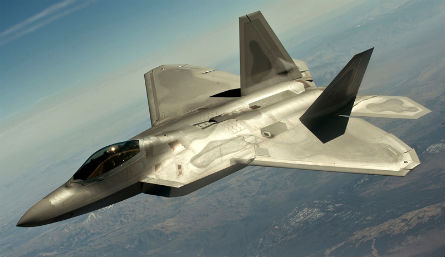The US Air Force could eventually develop swarms of nano-unmanned aircraft to conduct penetrating reconnaissance missions inside heavily defended airspace, but the service will rely on its stealthy fifth-generation fighter fleet to gather intelligence inside those areas for now.
"As you think about the A2/AD [anti-access/area denial] environment, I would offer that over the course of the last 10 years we been very good at operating in a permissive environment with airborne capabilities," says USAF intelligence chief Lt Gen Larry James speaking at an Air Force Association sponsored breakfast. "However if you think about the future conflicts that we may face, that is a non-permissive environment Frankly we may not have the ability, especially at the outset, to fly [General Atomics MQ-1] Predators or [MQ-9] Reapers."
That also applies to other non-stealth airborne intelligence collectors like the L-3 Communications RC-135 Rivet Joint aircraft.
 |
|---|
| ©US Air Force |
The USAF's Lockheed Martin F-22s and F-35s are probably going to be the only aircraft capable of gathering intelligence, surveillance and reconnaissance (ISR) data inside those hostile environments, James says. Both aircraft have an array of sensors that make them extremely capable intelligence collectors.
The USAF's scientific advisory board and Air Combat Command (ACC) are currently working on how to use the Lockheed Martin F-22 Raptor and F-35 Lightning II as intelligence, surveillance and reconnaissance platforms. That advisory board study should be complete by this summer, James says.
One of the major issues the two USAF organizations will examine is how to download the vast amount of data generated by the two fighters to intelligence analysts.
"Frankly, that is a hard question," James says. "How do you get the data off-board in that environment."
ACC will develop a roadmap based on the advisory board's conclusions on how to proceed with that the task of integrating the fifth-generation fighter fleet into the intelligence architecture, including the distributed common ground stations.
But ACC is already working on developing tactics, techniques and procedures for using the two stealth fighters in the ISR role, James says.
The USAF might also invest in standoff sensors that have the range to collect intelligence data from outside range of enemy defences. Other options include using more space-based collection systems or even cyber-based intelligence gathering efforts. It will probably require a combination of air, space and cyber-based collection to overcome A2/AD challenges though, James says.
But in the future there could be a new generation of penetrating unmanned aerial vehicles (UAV).
"Are there places for nano-UAVs that can be survivable or throwaway, networked small UAVs that can perhaps penetrate and operate for some period of time?" James says. "Those are things technologists need to look at."
Source: Flight International
















